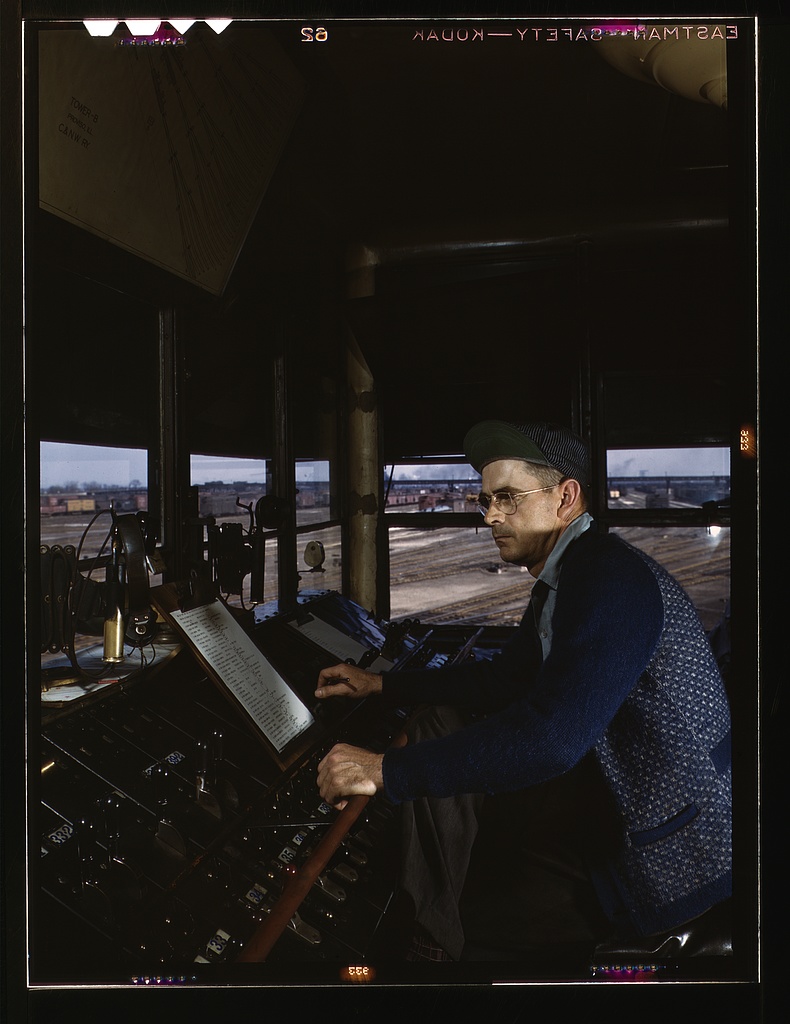The shunting takes place in classification yards. The aerial photo I showed the other day gives an idea of the shape and extent of the C&NW yards circa 1940. This is a detail from that image in which you can see the track layout.
 .
.Illinois Aerial Photos.[1]}
This photo shows portions of two of the C&NW's "ladders" — the sets of parallel tracks into which cars would be shunted. As in my previous post, it was taken for the Office of War Information by staff photographer Jack Delano and is found in collections of the Prints and Photographs Division, Library of Congress. Notice that, as you'd expect, each pair of tracks splits from a main feeder and each has its own switch. The feeder is called a lead or drill.

This shows a switchman in the act of shunting some cars. Delano took this in April 1943.[2]

The C&NW yards received lists via teletype showing the makeup of arriving trains and the destinations of their cars. These switch lists enabled workers such as the one shown below to map out the distribution of cars in the classification yards. The mapping is a lot easier to explain than it was to carry out in a place the size of proviso with its hundreds of switches.[3]

Cars would be pushed around the yards by shunt engines and in large facilities like the one at Proviso they might also be fed to the ladders by gravity. Locomotives would push a train up a gentle incline, called a hump, and the cars would be released to roll down the lead toward the switches.
This photo shows one of the humps at the C&NW yards. A tank car has just been uncoupled and is making its way down the hump toward the ladders.

This shows a shunt engine working on a lead. You can see two towers where towermen controlled the flow of cars from the hump down the lead and into the ladders.

In this view of the same set of ladders you can see the downslope from the hump at the foot of the foreground tower.

The caption explains this photo. The hump track to which it refers is continued by the lead or drill.

There were devices called retarders on the lead tracks. These were electrically controlled and could be used to slow down cars as they descended from the hump. Switches could also be electrically operated. This towerman is shown at the retarder and switch controls.[4]

I think Delano took this shot from one of the towers.

------
Some sources:
"Combination Through Classification and Terminal Yard" by W.C. Copley in Railway age Vol. 58 (Simmons-Boardman Publishing Corp., 1915)
Classification yard on wikipedia
Retarder on wikipedia
Switcher on wikipedia
Shunt (rail) on wikipedia
Train shunting puzzles on wikipedia
-----
Notes:
[1] This larger detail shows the complex interconnection of the classification yards the Proviso facility. Click to view full size.

[2] Jack Delano took all the images on this page on assignment from OWI in December 1942 and April 1943 and all are from collections of the Library of Congress.
[3] Railroaders have train shunting puzzles which are games that challenge players to break up and reassemble trains (called consists) with a minimum of de-couplings and couplings.
[4] This view of a classification yard (not C&NW) shows retarders on the leads just before the ladders. I've marked two of them with yellow circles.





No comments:
Post a Comment